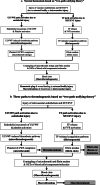Disseminated intravascular coagulation: new identity as endotheliopathy-associated vascular microthrombotic disease based on in vivo hemostasis and endothelial molecular pathogenesis
- PMID: 33061857
- PMCID: PMC7553785
- DOI: 10.1186/s12959-020-00231-0
Disseminated intravascular coagulation: new identity as endotheliopathy-associated vascular microthrombotic disease based on in vivo hemostasis and endothelial molecular pathogenesis
Abstract
Disseminated intravascular coagulation (DIC) can be correctly redefined as disseminated intravascular microthrombosis based on "two-path unifying theory" of in vivo hemostasis. "DIC" is a form of vascular microthrombotic disease characterized by "microthrombi" composed of platelets and unusually large von Willebrand factor multimers (ULVWF). Microthrombotic disease includes not only "DIC", but also microthrombosis occurring in thrombotic thrombocytopenic purpura (TTP), TTP-like syndrome, and focal, multifocal and localized microthrombosis. Being a hemostatic disease, microthrombotic disease occurs as a result of lone activation of ULVWF path via partial in vivo hemostasis. In endothelial injury associated with critical illnesses such as sepsis, the vascular damage is limited to the endothelial cell and activates ULVWF path. In contrast, in intravascular traumatic injury, the local damage may extend from the endothelial cell to subendothelial tissue and sometimes beyond, and activates both ULVWF and tissue factor (TF) paths. When endotheliopathy triggers exocytosis of ULVWF and recruits platelets, ULVWF path is activated and promotes microthrombogenesis to produce microthrombi composed of microthrombi strings, but when localized vascular damage causes endothelial and subendothelial tissue damage, both ULVWF and TF paths are activated and promote macrothrombogenesis to produce macrothrombus made of complete "blood clots". Currently, "DIC" concept is ascribed to activated TF path leading to fibrin clots. Instead, it should be correctly redefined as microthrombosis caused by activation of ULVWF path, leading to endotheliopathy-associated microthrombosis. The correct term for acute "DIC" is disseminated microthrombosis-associated hepatic coagulopathy, and that for chronic "DIC" is disseminated microthrombosis without hepatic coagulopathy. TTP-like syndrome is hematologic phenotype of endotheliopathy-associated microthrombosis. This correct concept of "DIC" is identified from novel theory of "in vivo hemostasis", which now can solve every mystery associated with "DIC" and other associated thrombotic disorders. Thus, sepsis-associated coagulopathy is not "DIC", but is endotheliopathy-associated vascular microthrombotic disease.
Keywords: Disseminated intravascular coagulation; Disseminated intravascular microthrombosis; Endotheliopathy; Fibrin clots; Fibrinogenesis; Hemostasis; Hepatic coagulopathy; Macrothrombogenesis; Microthrombogenesis; TTP-like syndrome; Thrombosis; Thrombotic thrombocytopenic purpura; Vascular microthrombotic disease.
© The Author(s) 2020.
Conflict of interest statement
Competing interests“The authors declare that they have no competing interests.”
Figures



Similar articles
-
Acute Respiratory Distress Syndrome as an Organ Phenotype of Vascular Microthrombotic Disease: Based on Hemostatic Theory and Endothelial Molecular Pathogenesis.Clin Appl Thromb Hemost. 2019 Jan-Dec;25:1076029619887437. doi: 10.1177/1076029619887437. Clin Appl Thromb Hemost. 2019. PMID: 31775524 Free PMC article.
-
COVID-19 Sepsis: Pathogenesis and Endothelial Molecular Mechanisms Based on "Two-Path Unifying Theory" of Hemostasis and Endotheliopathy-Associated Vascular Microthrombotic Disease, and Proposed Therapeutic Approach with Antimicrothrombotic Therapy.Vasc Health Risk Manag. 2021 Jun 1;17:273-298. doi: 10.2147/VHRM.S299357. eCollection 2021. Vasc Health Risk Manag. 2021. PMID: 34103921 Free PMC article. Review.
-
TTP-like syndrome: novel concept and molecular pathogenesis of endotheliopathy-associated vascular microthrombotic disease.Thromb J. 2018 Aug 11;16:20. doi: 10.1186/s12959-018-0174-4. eCollection 2018. Thromb J. 2018. PMID: 30127669 Free PMC article. Review.
-
Pathogenesis of Two Faces of DVT: New Identity of Venous Thromboembolism as Combined Micro-Macrothrombosis via Unifying Mechanism Based on "Two-Path Unifying Theory" of Hemostasis and "Two-Activation Theory of the Endothelium".Life (Basel). 2022 Jan 31;12(2):220. doi: 10.3390/life12020220. Life (Basel). 2022. PMID: 35207507 Free PMC article. Review.
-
Thrombogenesis and thrombotic disorders based on 'two-path unifying theory of hemostasis': philosophical, physiological, and phenotypical interpretation.Blood Coagul Fibrinolysis. 2018 Nov;29(7):585-595. doi: 10.1097/MBC.0000000000000769. Blood Coagul Fibrinolysis. 2018. PMID: 30234545 Review.
Cited by
-
Traumatized triad of complementopathy, endotheliopathy, and coagulopathy - Impact on clinical outcomes in severe polytrauma patients.Front Immunol. 2022 Oct 20;13:991048. doi: 10.3389/fimmu.2022.991048. eCollection 2022. Front Immunol. 2022. PMID: 36341368 Free PMC article.
-
The impact of vascular endothelial glycocalyx on the pathogenesis and treatment of disseminated intravascular coagulation.Blood Coagul Fibrinolysis. 2023 Dec 1;34(8):465-470. doi: 10.1097/MBC.0000000000001257. Epub 2023 Sep 28. Blood Coagul Fibrinolysis. 2023. PMID: 37823419 Free PMC article.
-
The pathophysiology, diagnosis, and management of sepsis-associated disseminated intravascular coagulation.J Intensive Care. 2023 May 23;11(1):24. doi: 10.1186/s40560-023-00672-5. J Intensive Care. 2023. PMID: 37221630 Free PMC article. Review.
-
Near-fatal cocaine intoxication in an infant with thrombotic microangiopathy associated with multiple organ failure.Rev Paul Pediatr. 2023 Aug 25;42:e2022159. doi: 10.1590/1984-0462/2024/42/2022159. eCollection 2023. Rev Paul Pediatr. 2023. PMID: 37646745 Free PMC article.
-
Vaccine-Associated Thrombocytopenia and Thrombosis: Venous Endotheliopathy Leading to Venous Combined Micro-Macrothrombosis.Medicina (Kaunas). 2021 Oct 26;57(11):1163. doi: 10.3390/medicina57111163. Medicina (Kaunas). 2021. PMID: 34833382 Free PMC article. Review.
References
-
- McKay DG. Disseminated intravascular coagulation: an intermediary mechanism of disease. Hoeber Medical Division of Harper and Row: New York; 1965.
Publication types
LinkOut - more resources
Full Text Sources
Miscellaneous

